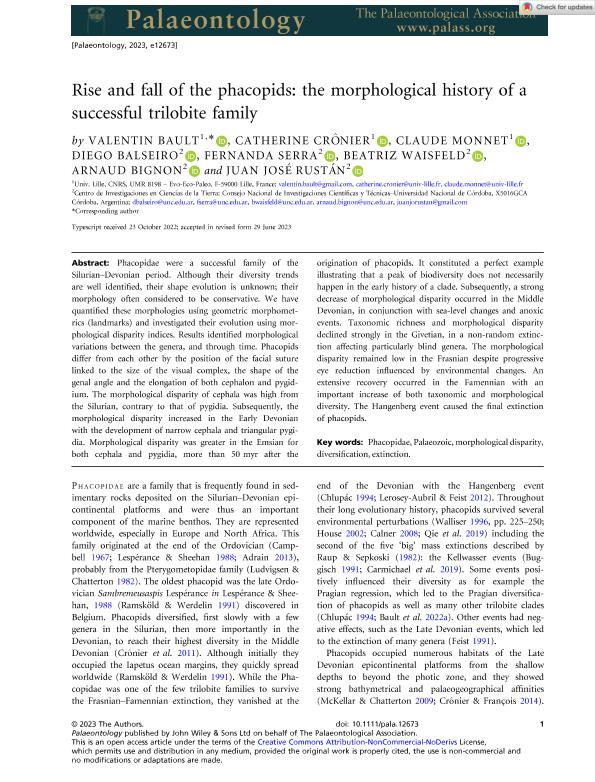Mostrar el registro sencillo del ítem
dc.contributor.author
Bault, Valentin

dc.contributor.author
Crônier, Catherine
dc.contributor.author
Monnet, Claude
dc.contributor.author
Balseiro, Diego

dc.contributor.author
Serra, Fernanda

dc.contributor.author
Waisfeld, Beatriz Graciela

dc.contributor.author
Bignon, Arnaud Marcel Jacques

dc.contributor.author
Rustán, Juan José

dc.date.available
2024-02-08T12:59:57Z
dc.date.issued
2023-09
dc.identifier.citation
Bault, Valentin; Crônier, Catherine; Monnet, Claude; Balseiro, Diego; Serra, Fernanda; et al.; Rise and fall of the phacopids: the morphological history of a successful trilobite family; Wiley Blackwell Publishing, Inc; Palaeontology; 66; 5; 9-2023; 1-21
dc.identifier.issn
0031-0239
dc.identifier.uri
http://hdl.handle.net/11336/226355
dc.description.abstract
Phacopidae were a successful family of the Silurian–Devonian period. Although their diversity trends are well identified, their shape evolution is unknown; their morphology often considered to be conservative. We have quantified these morphologies using geometric morphometrics (landmarks) and investigated their evolution using morphological disparity indices. Results identified morphological variations between the genera, and through time. Phacopids differ from each other by the position of the facial suture linked to the size of the visual complex, the shape of the genal angle and the elongation of both cephalon and pygidium. The morphological disparity of cephala was high from the Silurian, contrary to that of pygidia. Subsequently, the morphological disparity increased in the Early Devonian with the development of narrow cephala and triangular pygidia. Morphological disparity was greater in the Emsian for both cephala and pygidia, more than 50 myr after the origination of phacopids. It constituted a perfect example illustrating that a peak of biodiversity does not necessarily happen in the early history of a clade. Subsequently, a strong decrease of morphological disparity occurred in the Middle Devonian, in conjunction with sea-level changes and anoxic events. Taxonomic richness and morphological disparity declined strongly in the Givetian, in a non-random extinction affecting particularly blind genera. The morphological disparity remained low in the Frasnian despite progressive eye reduction influenced by environmental changes. An extensive recovery occurred in the Famennian with an important increase of both taxonomic and morphological diversity. The Hangenberg event caused the final extinction of phacopids.
dc.format
application/pdf
dc.language.iso
eng
dc.publisher
Wiley Blackwell Publishing, Inc

dc.rights
info:eu-repo/semantics/openAccess
dc.rights.uri
https://creativecommons.org/licenses/by-nc-nd/2.5/ar/
dc.subject
DIVERSIFICATION
dc.subject
EXTINCTION
dc.subject
MORPHOLOGICAL DISPARITY
dc.subject
PALAEOZOIC
dc.subject
PHACOPIDAE
dc.subject.classification
Paleontología

dc.subject.classification
Ciencias de la Tierra y relacionadas con el Medio Ambiente

dc.subject.classification
CIENCIAS NATURALES Y EXACTAS

dc.title
Rise and fall of the phacopids: the morphological history of a successful trilobite family
dc.type
info:eu-repo/semantics/article
dc.type
info:ar-repo/semantics/artículo
dc.type
info:eu-repo/semantics/publishedVersion
dc.date.updated
2024-02-06T13:30:28Z
dc.journal.volume
66
dc.journal.number
5
dc.journal.pagination
1-21
dc.journal.pais
Reino Unido

dc.journal.ciudad
Londres
dc.description.fil
Fil: Bault, Valentin. University Of Lille.; Francia. Centre National de la Recherche Scientifique; Francia
dc.description.fil
Fil: Crônier, Catherine. Centre National de la Recherche Scientifique; Francia. University Of Lille.; Francia
dc.description.fil
Fil: Monnet, Claude. University Of Lille.; Francia. Centre National de la Recherche Scientifique; Francia
dc.description.fil
Fil: Balseiro, Diego. Consejo Nacional de Investigaciones Científicas y Técnicas. Centro Científico Tecnológico Conicet - Córdoba. Centro de Investigaciones en Ciencias de la Tierra. Universidad Nacional de Córdoba. Facultad de Ciencias Exactas Físicas y Naturales. Centro de Investigaciones en Ciencias de la Tierra; Argentina
dc.description.fil
Fil: Serra, Fernanda. Consejo Nacional de Investigaciones Científicas y Técnicas. Centro Científico Tecnológico Conicet - Córdoba. Centro de Investigaciones en Ciencias de la Tierra. Universidad Nacional de Córdoba. Facultad de Ciencias Exactas Físicas y Naturales. Centro de Investigaciones en Ciencias de la Tierra; Argentina
dc.description.fil
Fil: Waisfeld, Beatriz Graciela. Consejo Nacional de Investigaciones Científicas y Técnicas. Centro Científico Tecnológico Conicet - Córdoba. Centro de Investigaciones en Ciencias de la Tierra. Universidad Nacional de Córdoba. Facultad de Ciencias Exactas Físicas y Naturales. Centro de Investigaciones en Ciencias de la Tierra; Argentina
dc.description.fil
Fil: Bignon, Arnaud Marcel Jacques. Consejo Nacional de Investigaciones Científicas y Técnicas. Centro Científico Tecnológico Conicet - Córdoba. Centro de Investigaciones en Ciencias de la Tierra. Universidad Nacional de Córdoba. Facultad de Ciencias Exactas Físicas y Naturales. Centro de Investigaciones en Ciencias de la Tierra; Argentina
dc.description.fil
Fil: Rustán, Juan José. Consejo Nacional de Investigaciones Científicas y Técnicas. Centro Científico Tecnológico Conicet - Córdoba. Centro de Investigaciones en Ciencias de la Tierra. Universidad Nacional de Córdoba. Facultad de Ciencias Exactas Físicas y Naturales. Centro de Investigaciones en Ciencias de la Tierra; Argentina
dc.journal.title
Palaeontology

dc.relation.alternativeid
info:eu-repo/semantics/altIdentifier/url/https://onlinelibrary.wiley.com/doi/10.1111/pala.12673
dc.relation.alternativeid
info:eu-repo/semantics/altIdentifier/doi/http://dx.doi.org/10.1111/pala.12673
Archivos asociados
